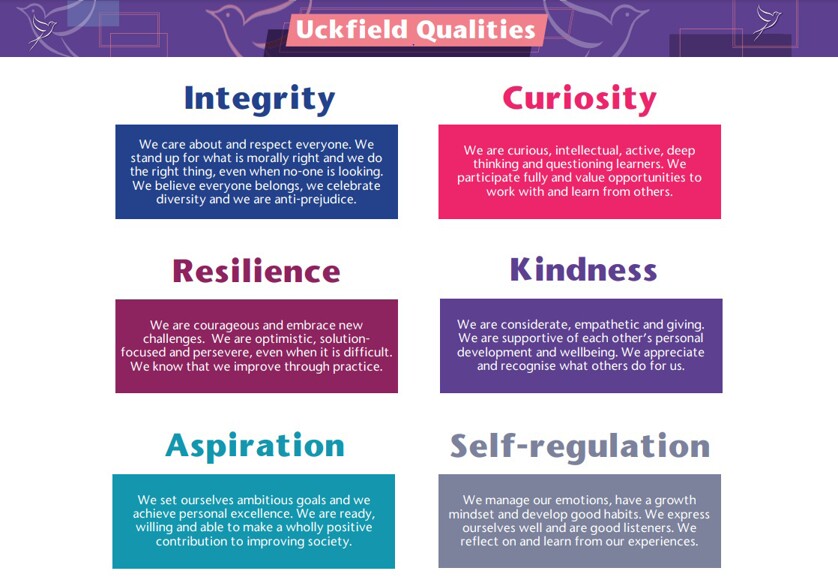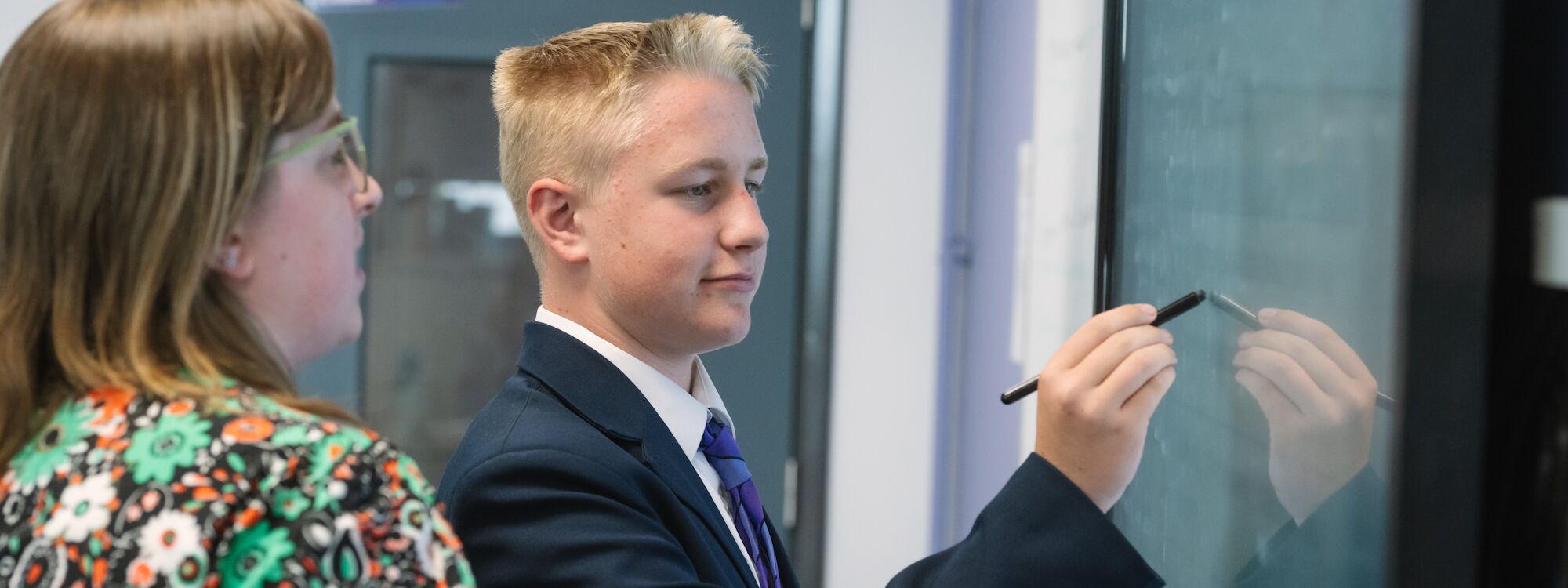At Uckfield, excellent, inspiring teaching and learning is at the heart of what we do.
Our knowledge-rich, ambitious curriculum aims to develop a love of learning and a deep body of knowledge in each of the different subjects. Hinterland knowledge and cultural transmission, a wide vocabulary, the building of schema and understanding of relevance are all key.
We invest significantly in the quality of ongoing professional development for our talented, specialist teaching staff and use the most significant and reliable educational research to inform our practice.
This leads to excellent examination results and beyond that, students leave Uckfield College as creative, confident, knowledgeable people, who are ready to flourish in the next stages of their lives.
What are our aims for each and every Uckfield student? What kind of student are we developing?
Our Curriculum intent is that every student is an Uckfield ACE:
A. Academic Achievers:
- Critical, creative, hard thinkers and learners
- Confident and knowledgeable speakers with large vocabularies (over 50,000 words) by the time they leave year 11
C. Citizens of our world with good Character:
- Social activists: engaged, responsible, knowledgeable, tolerant,
outward-looking
- Ready, willing and able to make a wholly positive contribution to
improving society
E. Enterprising and confident:
- Personally developed and personally knowledgeable -physically, mentally, socially and emotionally
- Able to think for themselves, be innovative, aspirational and to use their knowledge confidently
Intrinsic to this, are our Uckfield Qualities, which are the values we teach through every aspect of the curriculum:

Our curriculum is at the heart of our provision and is informed by these guiding principles:
Inspiration and creativity: we develop our schemes of learning so that they are as interesting and as motivational for students as possible
Stretch and challenge for all: our curriculum in all subjects for all students is knowledge-rich and ambitious. There are different pathways that offer additional challenge or support, as appropriate to different groups of students.
Choice at KS4 and KS5: we believe that students thrive when they have a combination of courses that they find challenging and interesting. As a large school, we are able to offer a wide selection of subjects. Our aim is that all students have a broad and balanced curriculum from Years 7-11.
Progression: the curriculum is designed so it ‘secures good progression’ to sixth form and from the sixth form to employment or university.
What the available and relevant research tells us - both about the curriculum intent, and its implementation.
We value inspiring lessons that are pitched to the top of every class, and that are challenging and engaging for all. Curriculum thinking has to be bold and ambitious - we are a challenge-seeking species and all children enjoy difficult work as long as they have appropriate scaffolding and support. The curriculum must be high-reaching and stretching for all students.
Another guiding principle is that our curriculum aims to develop a love of learning and a deep body of knowledge in each of the different subjects and must not, for example, become a reductive curriculum based, for example, based extensively on practising GCSE terminal questions too early in a student’s education. Hinterland knowledge and cultural transmission, a wide academic vocabulary, the building of schema and understanding of relevance are all central to curriculum design at Uckfield. Within a subject’s curriculum, there should also be opportunities for students to practise, to receive feedback and to refine, and to produce work of a very high standard of which students can be very proud.
Our ambition for all students with SEND is high and we believe that all students should be able to access, achieve and progress through the curriculum. For those SEND students who have low prior attainment, students need to be able to access the challenging curriculum and for it to be adapted appropriately with ‘structured steps’. In addition to supporting students with emotional and cognitive difficulties, there is also a very significant commitment to students joining the school with low reading ages to make rapid progress with their reading.
Our expectations for an ambitious, precisely planned and knowledge-rich curriculum
- Knowledge here can be defined as both factual and procedural knowledge (i.e. skills and understanding). Therefore, knowledge includes those concepts, facts, ideas, stories, techniques and procedures which are important to know in order to have a deep understanding of a subject.
- Powerful knowledge gives students the cultural capital they need to be able to take their place as informed, active citizens, be increasingly aspirational for their future choices, and excel in further academic study.
- Desirable skills such as analysis, explanation, creativity, evaluation and independence of thought are only possible when a wide knowledge base is secure; all thinking involves connecting new ideas to existing knowledge.
- Powerful knowledge includes knowing the language required to apply knowledge. Therefore, the best language for students to learn in order to apply their knowledge at each point in the curriculum should be specified, taught and practised.
- Therefore, greater emphasis should be given to knowledge, with a view to covering ‘fewer things in greater depth’ where possible, and a commitment to the idea that overall, students will be taught, understand and retain much richer knowledge.
- Curriculum planning should define and precisely specify the core knowledge and core skills that are regarded as most important for students to learn. These should be shared with students through Personal Learning Checklists and through subject specific vocabulary. This curriculum planning is documented in high quality schemes of learning that are regularly reviewed and updated with pedagogical advice and differentiation.
- Where curriculum content is precisely specified, clarity is provided which supports teacher workload, helps students understand the progress they are making, and enables high quality intervention for those who are not being successful. On the other hand, vague or unspecific curriculum content is burdensome for teachers, and a contributor to excessive or inefficient workload.
Exceptional planning and sequencing
- Careful and skilful curriculum sequencing and planning is essential if students are likely to secure and retain knowledge.
- This requires that the order in which students are exposed to core knowledge is carefully specified and planned so that concepts lead on from one another.
- Effective sequencing (including spaced learning and interleaving) also involves specifying exactly when and how core concepts will be returned to so that they are retained over time.
- Where it is sensible to do so, planning should take into account the content that is being taught, or has been taught, in other curriculum areas at any point. Links between subject areas – for example where the same period is being considered in English, Art and History – should be understood and capitalised on by teachers in each subject. All teachers are teachers of literacy and numeracy, where applicable to their subject.
- An effective curriculum therefore will have a very clear and convincing rationale for what is taught, and the order that it is taught in. It will clearly identify end points for each scheme of learning and each year group: core concepts, knowledge, ideas, words and skills, and will specify when they are to be introduced, and when / how they are returned to.
How does the College decide what is contained in its subject curriculum, beyond the statutory requirements?
Curriculum leaders use the following 7 principles of curriculum design from Dylan Wiliam to evaluate curriculum proposals as they are being developed:
- Balance - we believe we have to ‘future-proof’ our students with a broad and balanced curriculum which promotes the intellectual, moral, spiritual, aesthetic, creative, emotional and physical development of the child. We prepare our students for an ever changing world by teaching them traditional moral values that have stood the test of an ever changing past.
- Rigour - the traditional school disciplines represent powerful and qualitatively different ways of thinking about the world. To be rigorous, a curriculum needs to develop disciplinary habits of mind - powerful ways of thinking that are developed through sustained engagement with the discipline. A common, but mistaken, assumption about traditional subject disciplines is that they can be replaced with, ‘21st century skills’ eg communication and critical thinking - these are already part of the main disciplines and also different according to different subjects, eg critical thinking in History is very different to critical thinking in maths.
- Coherence (within and between subjects) - the connections between different parts of the curriculum are very important. Our short-term working memory is limited, and cannot be increased, but background semantic knowledge enables us to make more effective use of whatever short-term memory we have.
- Vertical integration - eg promoting progression in learning . Our schemes of learning provide a clear plan for the development of learning over 5/7 years. Careful sequencing of topics leads to clearer connections between different topics, fewer things for students to remember and therefore more effective learning. This kind of careful sequencing takes planning and is best done as a collaborative venture between teachers.
- Appropriacy - we know that the rate at which children learn varies to quite an extraordinary degree and, therefore, the curriculum must take into consideration the best time for different learners to learn different topics, and how this can be organised most effectively.
- Focus - the curriculum can be too full with a great deal of material to be taught; this can result in a curriculum that is ‘a mile wide and an inch deep’. Generally, the only way to improve a curriculum is to leave out important material so that the teacher and students can spend more time on more important material. One of the key steps in designing a curriculum, therefore, is to be clear about what the ‘big ideas’ of the subject are. This is, in general, a very difficult task, requiring profound subject knowledge and substantial teaching experience. But these are the essential discussions to have. It is also important that the big ideas need not always be stated as outcomes. Sometimes, they are just things that we want young people to experience.
- Relevance - What is in the intended curriculum is rarely, at face value, ‘relevant’ to students. What makes curriculum relevant is the way that teachers connect valued outcomes to the students in front of them - the extraordinary way that good teachers get students interested in things they never knew they were interested in. Students need to understand the relevance of subjects to their future lives.
Teaching Reading
The College has a 5 point reading strategy, which encapsulates the approaches taken to the teaching of reading, which is a significant priority:
- Phonics. The code for sound. Teach the code.
- Fluency. Build students' reading fluency in order to increase ease, stamina and comprehension.
- Vocabulary. Teach it explicitly, every lesson.
- Disciplinary Literacy. Background knowledge. Reading instruction in every subject. Make connections; teach strategies.
- Making children readers. Develop learners’ confidence and enjoyment in reading.
These principles mean that reading is explicitly taught in every lesson through the acquisition of vocabulary and disciplinary literacy. For students whose reading ages are significantly below age-related expectations, interventions including Direct Instruction and Lexia are used to secure students’ understanding of phonics. Reading is promoted and celebrated throughout the school, including through a precisely planned form-time reading curriculum and through Reading Room lessons. We strongly encourage all students to read at home every day for 30 minutes and three times a week for twenty minutes as an absolute minimum.


